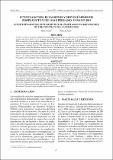Por favor, use este identificador para citar o enlazar este ítem:
https://hdl.handle.net/20.500.12958/7533Registro completo de metadatos
| Campo DC | Valor | Lengua/Idioma |
|---|---|---|
| dc.contributor.author | Pinedo, Elda | - |
| dc.contributor.author | Ayón Dejo, Patricia | - |
| dc.date.accessioned | 2023-04-24T19:33:50Z | - |
| dc.date.available | 2023-04-24T19:33:50Z | - |
| dc.date.issued | 2023-03 | - |
| dc.identifier.citation | Pinedo, E. y Ayón, P. (2023). Ictioplancton, eufáusidos y biovolúmenes de zooplancton del mar peruano, verano 2019. Inf Inst Mar Perú, 50(1), 47-59. | es_ES |
| dc.identifier.issn | 0378-7702 | - |
| dc.identifier.uri | https://hdl.handle.net/20.500.12958/7533 | - |
| dc.description.abstract | A bordo de los BIC Olaya y Humboldt, del 12 de febrero al 27 de marzo 2019 se realizó el Crucero de Evaluación Hidroacústica de Recursos Pelágicos 1902-03. Fueron determinados huevos y larvas de 32 familias y 64 especies de ictioplancton. Los huevos y larvas de anchoveta fueron más abundantes, variando de 3 a 17 952 huevos.m-2 y de 3 a 1 500 larvas.m-2. Desde Talara hasta Cerro Azul, en la zona costera fueron localizados mayores desoves. Los huevos y larvas de Vinciguerria también presentaron importantes concentraciones con valores de 3 a 2 553 huevos.m-2 y de 3 a 222 larvas.m-2, distribuidos por fuera de la plataforma continental. Además del ictioplancton, fueron determinadas 13 especies de eufáusidos, siendo Euphausia mucronata más abundante. Los biovolúmenes de zooplancton oscilaron entre 0,01 y 8,78 mL.m-3, con valores >0,5 mL.m-3 distribuidos principalmente por fuera de las 10 mn. | es_ES |
| dc.description.abstract | ABSTRACT: From February 12 to March 27, 2019, a hydroacoustic assessment cruise for pelagic resources (1902-03) was conducted aboard the R/Vs Olaya and Humboldt along the Peruvian coast. The cruise aimed to study the ichthyoplankton, euphausiids, and zooplankton biovolumes. A total of 32 families and 64 species of ichthyoplankton were identified, with Engraulis ringens eggs and larvae being the most abundant, ranging from 3 to 17,952 eggs.m-2 and from 3 to 1,500 larvae.m-2. The highest spawning concentrations were found in the coastal area between Talara and Cerro Azul. Eggs and larvae of Vinciguerria also showed significant concentrations, with values of 3 to 2,553 eggs.m-2 and from 3 to 222 larvae.m-2, distributed outside the continental shelf. Thirteen species of euphausiids were also identified, with Euphausia mucronata being the most abundant. Zooplankton biovolumes ranged from 0.01 to 8.78 mL.m-3, with values >0.5 mL.m-3 distributed mainly outside the 10 nm zone. | - |
| dc.language | spa | - |
| dc.language.iso | spa | es_ES |
| dc.publisher | Instituto del Mar del Perú | es_ES |
| dc.relation.ispartofseries | Informe IMARPE 50(1), 2023; | - |
| dc.rights | info:eu-repo/semantics/openAccess | es_ES |
| dc.rights.uri | https://creativecommons.org/licenses/by/4.0/ | es_ES |
| dc.source | Instituto del Mar del Perú - IMARPE | es_ES |
| dc.source.uri | Repositorio Digital IMARPE | es_ES |
| dc.subject | Engraulis ringens | es_ES |
| dc.subject | Euphausia mucronata | es_ES |
| dc.subject | Ictioplancton | es_ES |
| dc.subject | Larvas | es_ES |
| dc.title | Ictioplancton, eufáusidos y biovolúmenes de zooplancton del mar peruano, verano 2019 | es_ES |
| dc.title.alternative | Ichthyoplankton, euphausiids, and zooplankton biovolumes of the Peruvian sea (summer 2019) | es_ES |
| dc.type | info:eu-repo/semantics/article | es_ES |
| dc.publisher.country | Perú - Callao | es_ES |
| dc.subject.ocde | http://purl.org/pe-repo/ocde/ford#1.06.12 | es_ES |
| Aparece en las colecciones: | Informe vol. 50(1) 2023 | |
Ficheros en este ítem:
| Fichero | Descripción | Tamaño | Formato | |
|---|---|---|---|---|
| Informe 50-1 articulo 4.pdf | 1,18 MB | Adobe PDF |  Visualizar/Abrir |
Este ítem está sujeto a una licencia Creative Commons Licencia Creative Commons

